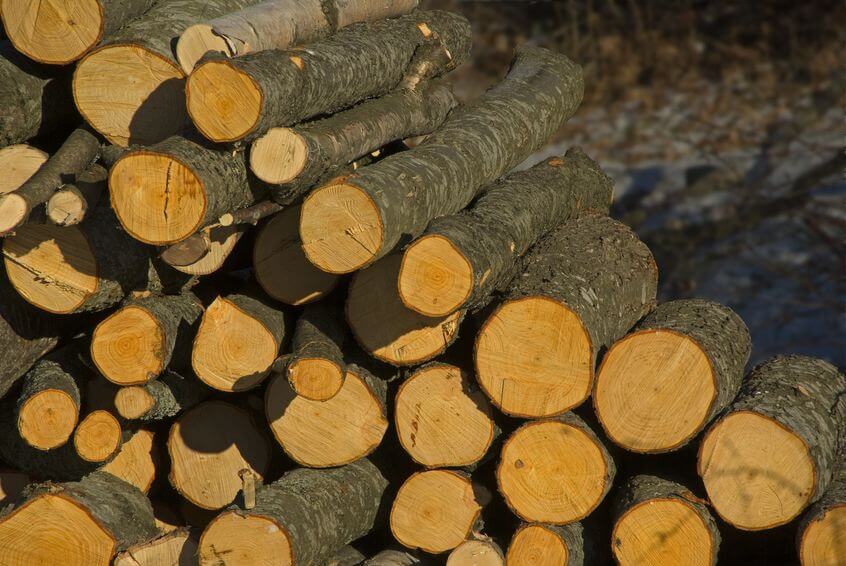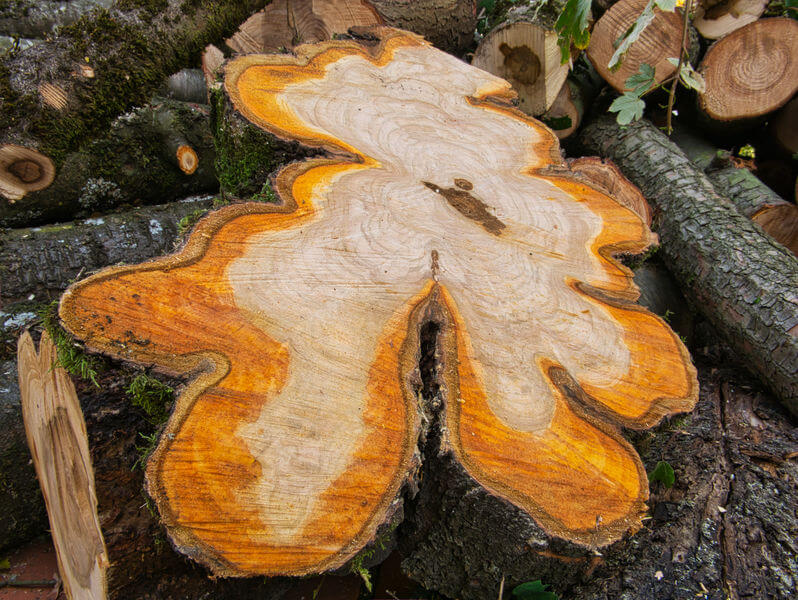If you’ve ever come across cherry wood, you might be wondering, “does cherry wood have a smell?” Well, my curious friend, you’re in the right place! In this article, we’re going to explore the captivating world of cherry wood and give you the lowdown on its aromatic qualities.
Now, picture this: you walk into a room and immediately catch a whiff of a delightful scent that puts a smile on your face. That could very well be the enchanting aroma of cherry wood. Yes, you heard it right – cherry wood does have a smell!
But hold on, there’s more to this story. We’re going to dive deep into the distinctive scent of cherry wood, its origins, and why it’s highly sought-after in furniture and woodworking. So, get ready to embark on a fragrant journey as we unravel the secrets of cherry wood’s captivating aroma!

Does Cherry Wood Have a Smell? Exploring the Aromatic Qualities of Cherry Wood
Cherry wood is known for its beautiful grain pattern and rich color, but does it have a distinct smell? Many people wonder if this type of wood has a unique aroma that adds to its appeal. In this article, we will delve into the olfactory characteristics of cherry wood and explore whether it possesses a notable scent.
1. Understanding the Natural Fragrance of Cherry Wood
Cherry wood is derived from the cherry tree, specifically the heartwood found in the trunk and larger branches. When freshly cut, cherry wood emits a mild, sweet scent reminiscent of cherries or almonds. This aroma comes from the natural compounds present within the wood, such as benzaldehyde and benzyl alcohol. Over time, the scent of cherry wood may mellow and become less noticeable as the wood ages and oxidizes. However, when the wood is exposed to heat or friction, the pleasant fragrance can be revived.
The distinct smell of cherry wood is highly subjective, and different individuals may perceive it differently. Some people find the aroma enticing and soothing, while others may find it too subtle to be noticeable. Additionally, the scent of cherry wood can vary depending on factors such as the age of the wood, the tree species, and the region in which it was harvested. Ultimately, the olfactory experience of cherry wood is a personal one that may differ from person to person.
2. Scented Variations of Cherry Wood
While the natural scent of cherry wood is generally described as mild and sweet, there are variations of cherry wood that have been intentionally infused or treated to enhance or alter the fragrance. For example, there are cherry wood products that have been treated with oils or finishes that impart additional aromas, such as vanilla, cinnamon, or cedar. These scented variations can provide a unique olfactory experience and are often used in the production of furniture, cabinets, and other wood products.
It’s worth noting that scented cherry wood products should be carefully selected and considered based on individual preferences. The added fragrances may enhance or mask the natural scent of cherry wood, depending on personal taste. Additionally, scented cherry wood products may require specific care and maintenance to preserve their fragrance over time.
3. The Benefits of Cherry Wood’s Aroma
The aroma of cherry wood can contribute to the overall sensory experience of using and owning cherry wood products. The subtle scent can create a warm and inviting ambiance, particularly in indoor environments like living rooms or bedrooms. Some people appreciate the calming effects of the natural wood fragrance, finding it soothing and relaxing. The aromatic qualities of cherry wood can also bring a touch of nature indoors, evoking a connection to the outdoors and the beauty of the cherry tree.
In addition to its olfactory appeal, cherry wood offers numerous other benefits. It is known for its durability, strength, and resistance to wear and tear. Cherry wood is also prized for its attractive grain pattern, which can range from straight and uniform to wavy and irregular, adding to its visual appeal. Furthermore, cherry wood is often used in high-quality furniture and cabinetry due to its workability and ability to take on a smooth, lustrous finish.
Cherry Wood: A Versatile and Desirable Choice
4. The Versatility of Cherry Wood
Cherry wood is highly versatile and can be used in a variety of applications, including furniture, flooring, paneling, and musical instruments. Its warm reddish-brown color deepens over time, creating a rich patina that adds character to any space. In furniture design, cherry wood is often chosen for its ability to be shaped and carved into intricate details, showcasing the craftsmanship of the piece. Its timeless beauty and adaptability make cherry wood a popular choice for both traditional and contemporary interiors.
5. Cherry Wood vs. Other Hardwoods with Aromas
When it comes to wood with distinctive aromas, cherry wood is not alone. Several other hardwoods possess their own unique scents that can enhance the sensory experience. For example, cedar wood is renowned for its rich, woody aroma that acts as a natural repellent against insects. Oak wood emits a mild, earthy scent, while walnut wood has a slightly nutty fragrance. Each of these hardwoods brings its own olfactory charm to the table, allowing individuals to choose the wood that resonates most with their preferences.
6. Caring for Cherry Wood and Maintaining its Scent
To preserve the scent and beauty of cherry wood, proper care and maintenance are essential. Here are some tips to ensure your cherry wood products remain in optimal condition:
1. Avoid direct sunlight: Prolonged exposure to sunlight can cause cherry wood to fade and lose its natural color and luster. Use curtains or blinds to protect your cherry wood furniture or flooring from the sun’s damaging UV rays.
2. Regular cleaning: Dust and debris can accumulate on cherry wood surfaces, so it’s important to clean them regularly with a soft, lint-free cloth. Avoid using harsh chemicals or abrasive cleaners that can damage the wood’s finish.
3. Moisturize with wood polish: Apply a high-quality wood polish specifically designed for cherry wood to keep it moisturized and enhance its shine. Follow the manufacturer’s instructions for best results.
4. Handle with care: When moving or rearranging cherry wood furniture, take care to lift and avoid dragging it to prevent scratches or damage to the wood’s surface.
In summary, cherry wood does have a distinct smell, characterized by a mild and sweet aroma. While its scent may vary for different individuals and can fade over time, the olfactory experience of cherry wood adds to its overall appeal. The versatility, durability, and aesthetic beauty of cherry wood make it a desirable choice for various applications. Whether it’s the natural fragrance or scented variations, cherry wood brings an inviting and warm ambiance to any space. By properly caring for cherry wood products, you can preserve its scent and enjoy its beauty for years to come.
Key Takeaways:
- Yes, cherry wood does have a distinct smell.
- The smell of cherry wood is often described as sweet and fruity.
- The scent of cherry wood can vary depending on the age and condition of the wood.
- Cherry wood can release its fragrance when it is freshly cut or sanded.
- Some people find the smell of cherry wood to be pleasant, while others may not enjoy it as much.
Frequently Asked Questions
In this section, we’ll explore some common questions about the smell of cherry wood.
1. Why is cherry wood often associated with a distinctive smell?
Cherry wood is known for its unique fragrance due to the natural compounds and essential oils present in the wood. As cherry trees grow, they release volatile organic compounds, which contribute to the characteristic smell.
Once the wood is harvested and used in furniture or other applications, these compounds take some time to evaporate and the scent becomes more noticeable. However, not all cherry wood has a strong smell, as it can vary depending on factors such as age and how it is treated or finished.
2. Is the smell of cherry wood pleasant?
Many people find the smell of cherry wood to be pleasant and often describe it as sweet, fruity, or reminiscent of cherries. It adds a natural and inviting aroma to spaces where cherry wood furniture or accents are present.
However, scent is a subjective experience, and individual preferences may vary. Some people may find the smell too strong or overpowering, particularly in confined spaces. It’s always a good idea to consider personal preferences and test out the scent before committing to cherry wood furniture or products.
3. Can the smell of cherry wood change over time?
Yes, the smell of cherry wood can evolve over time. When freshly cut, cherry wood typically has a stronger aroma. As the wood ages and reacts with the surrounding environment, the scent can mellow and become more subtle over the years.
Additionally, the smell of cherry wood can be influenced by factors such as humidity, temperature, and exposure to sunlight. These external factors can alter the scent profile of the wood, making it important to consider the long-term changes in smell when working with or enjoying cherry wood products.
4. How can I enhance or preserve the smell of cherry wood?
To enhance or preserve the smell of cherry wood, you can use various methods. One approach is to apply a natural wood finish or oil that helps lock in the scent and maintain its freshness. These finishes also offer protection to the wood, ensuring its longevity.
Another option is to occasionally polish the wood using natural cleaners or oils specifically designed for wood surfaces. This can help rejuvenate the scent and bring out the natural beauty of the cherry wood.
5. Can cherry wood products emit a smell for people with sensitivities or allergies?
While cherry wood is generally considered safe and non-allergenic, some individuals with specific sensitivities or allergies may have a reaction to the smell or compounds present in the wood. It’s always recommended to test your tolerance to the scent before bringing cherry wood furniture or products into your living space.
If you have known sensitivities, it may be helpful to consult with a professional or choose alternative wood options that are less likely to cause irritation. Proper ventilation and regular cleaning can also help minimize any potential issues related to the scent of cherry wood in enclosed spaces.

Darken CHERRY Wood the RIGHT WAY
Summary
Cherry wood does have a smell, and it’s a pleasant and sweet aroma that many people enjoy. This smell is often described as a mix of fruity, floral, and spicy notes. The scent can vary depending on the type of cherry wood and how it’s processed.
Cherry wood also has practical benefits beyond its scent. It is a durable and beautiful wood that is commonly used in furniture making. It has a reddish-brown color with a smooth grain pattern, making it a popular choice for creating elegant and timeless pieces. So, if you ever come across cherry wood furniture or items, take a good sniff and enjoy its lovely fragrance.
